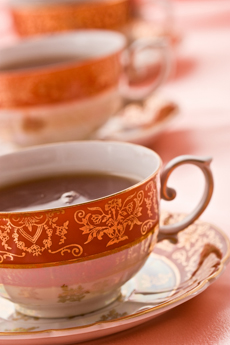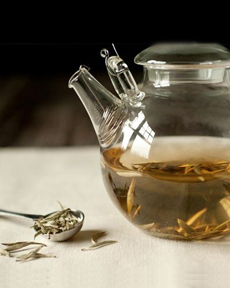

Fine tea should be drunk without milk or sweetener. Photo by A.G. Photographer | CSP.
January 2006
Last Updated June 2014
|
 |
How To Make Tea
Learning To Brew The Perfect Cup Of Tea Is An Art
And A Science
Introduction
Much is written about making the perfect cup of tea. With more people investing in fine loose teas, there’s an art and a science to brewing, starting with the vessel.
- Tea should be brewed in a porcelain, ceramic or glass pot or cup—aluminum can impart a metallic taste in the tea infusion.
- Never pour tea into a carafe that is also used for coffee. Unless carafes are scrupulously scrubbed after each use—not just washed with soap and water—coffee oils remain and will transfer slight nuances of coffee flavor to the tea.
- How much tea should you buy? Even though it’s dried, tea loses its freshness within 6 months. Buy what you’ll use within that time frame—it’s no bargain if you throw out “dead tea in two years.
- One pound of loose tea makes about 200 cups. 3.5 ounces makes about 20 cups.
- Tea that has lost its flavor can be used in the refrigerator and freezer, like baking soda, to soak up odors.
This is Page 1 of a four-page article. Click on the black links below to visit other pages.
Boiling The Water
Always boil fresh-drawn cold water. Purists will let the water flow freely from the faucet for a minute or two to allow it to become fully aerated; this provides the most flavorful tea. Bring the water to a rolling boil, but do not let it continue to boil, as this will boil out the oxygen. Similarly, don’t re-boil previously heated water: the tea will taste flatter because it will no longer be aerated. This is also why purists will never use water from a hot water tap, or water that has been boiled in a microwave.
- Black and oolong teas should be brewed with almost-boiling water. While most of us pour boiling water directly onto the leaves, some specialists claim that water at 212°F burns the leaves; they recommend letting boiled water sit for 30 seconds so that it cools a bit, to 200°-205°F or so.
- Green tea and white teas can get bitter when brewed with boiling water. Ideally it should be brewed at 185° to 190°F.
- While thermometers are sold to measure the temperature of tea, you can use the meat or candy thermometer you already have. You can either let boiled water cool for a few minutes or let the water heat to just under boiling.
Water Quality
The quality of the water is as important as the quality of the tea.
If you prefer to drink bottled water over your local tap water, the same flavors you don’t like from the tap will carry over to your tea.
Tea is much more subtle in flavor than coffee, where the minor flavors in water are more readily covered up.
- Carbon Filter. Consider installing a carbon filter (not an inexpensive screw-on at the faucet, but an under-the-sink model—you can get one for about $200 plus installation). If you drink fine tea straight (without milk and sugar, as it should be drunk), you’ll appreciate the difference.
|
|

The flavor of white tea is so delicate, it demands the purest water. Photo courtesy Republic Of Tea. |
- Spring Water. If you don’t have a filter but do have chemical- or mineral-tasting water, use spring water. What you lose in the oxygenation from running tap water you gain in purity of flavor. Water from a spring water dispensing system, such as five-gallon containers, will also provide oxygenated water.
- Soft Water. Soft water is best for tea. Hard water is not ideal: It can leave a film of oil floating in the cup, which is the interaction between the flavonoids in the tea and calcium hydroxide in the water. If you have hard water in your home you can have a water softener or water softener alternative installed fairly easily.
Continue To Page 2: Brewing The Tea
Go To The Article Index Above
Lifestyle Direct, Inc. All rights reserved. Images are the copyright of their individual owners.

|





